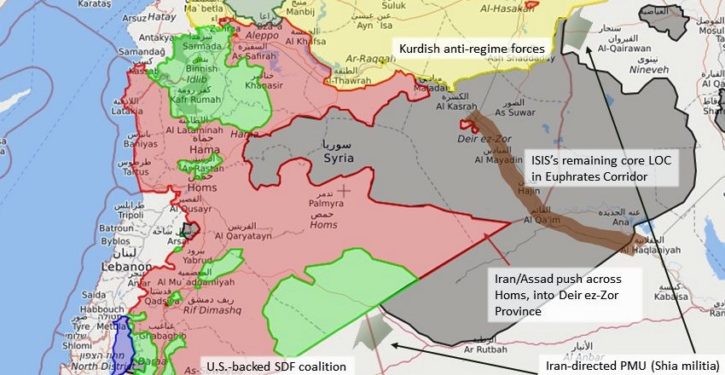
Last week, the Security Studies Group, Jim Hanson’s and Dave Reaboi’s next-gen think tank, published an excellent, well-organized article on Iran as the “first threat” America needs to address. The post is timely; many commentators are recognizing the urgent need for a grand strategy to deal with Iran, which packs a wallop with terror sponsorship, proxy wars, near-nuclearization, and the resources of a large nation-state to put behind radical, apocalyptic Islamism.
In analyzing the dimensions of the problem, the SSG article suggests the outlines of such a strategy. After looking at the vectors of the Iranian threat and the geography of the problem-set, the authors funnel down their recommendations (the ones in this post, at least) to address two key policy areas: the JCPOA, and the Iraq/Syria end game.
As regular readers know, I’ve written on these topics before, and specifically about U.S. interests in the Iraq/Syria end game, in particular as they relate to blocking Iran’s advance westward to the Mediterranean. The SSG article alludes to this advance by Iranian forces as a significant concern; it is what I want to discuss here.
Will this presidential election be the most important in American history?
Iran has been steadily making the advance since 2014, always on the pretext of fighting ISIS enclaves in Iraq. If Iran can effect the link-up she is clearly going for – holding the territory from Baghdad westward through the Euphrates Corridor, to Deir ez-Zor in Syria – Iran will have her choice of land approaches to the Med. Two routes, dovetailing through Damascus, lie across Syria. The other passes through Jordan. (Maps below.)
If Iran can gain the ability to effectively dominate these routes – even if that ability is in a latent form, not exercised until Iran is ready to move – she can flank both Lebanon and Israel in a pincer action.


Deir ez-Zor is the key. And the key to Deir ez-Zor is the ISIS-dominated territory that still lies between Deir ez-Zor and Haditha, Iraq.
A nod to the big picture
Before turning to the pivotal role this strip of territory plays in America’s posture on the Iraq/Syria end game, let me make the point that a blocking strategy on the Euphrates Corridor won’t succeed on its own.
It has to be part of a larger strategy to deter and pressure Iran on all fronts: diplomatic, economic, informational, and military. I would first commend the SSG post to your perusal as a very comprehensive survey of what that strategy has to address.
The only thing I would really add to it is an acknowledgment of Iran’s activities in Latin America. Those activities combine (a) the potential for creating new threats to the U.S. homeland with (b) opportunities for Iran to buy key resources like uranium (also here), launder money and hide sanctioned activities, and earn cash outright through syndicate crime (in which Hezbollah has long been known to be engaged). Being in bed with Castro, Maduro, and Ortega opens up possibilities for all those hazards and more.
There are more moving parts in the Iran strategic problem than there were in the problem of the USSR and Warsaw Pact – ironically, in one sense, because Iran is a smaller nation. But the multipronged strategy used against the USSR by Ronald Reagan is a good model for what is needed in the case of Iran.
It can’t be executed on exactly the same basis; just to take one example, it is virtually certain that there can be no unified, EU-endorsed renewal of economic sanctions on Iran. Even the less-than-ideal level of allied unity achieved by the U.S. and Europe in pressuring the Soviets economically in the 1980s is probably unattainable.
But that doesn’t mean there’s no way to have an economic impact. Keeping oil and gas prices low, and encouraging plenty of competitors to petroleum products from Iran, will put market forces at work against Iran’s bottom line. It will also ease Europe’s larger problem of diversifying and securing access to oil and gas, reducing the particular value of buying them from Iran (e.g., as opposed to Russia or Africa). The same is true for allies like Japan and South Korea.
Within the U.S. national security establishment, the biggest philosophical obstacles to a comprehensive Iran strategy will probably be the establishment’s reflexive resistance to overturning the JCPOA (see the SSG discussion on that), and to embracing the prospect of internally-driven regime change in Iran.
We ought to embrace the latter; we do not need to remake Iran, but the Iranian people can, and should. The State Department, however, is notoriously hostile to the idea of regime change for radical, anti-American regimes. Its posture is extremely defensive in this regard: beyond opposing active counter-regime measures, the State Department will probably resist measures that are in America’s interest, but might incidentally induce Iranians to lose more faith in their regime, and increase their desire to alter it.
So it will be necessary to keep in mind that weakening Iran’s radical, repressive, regionally disruptive regime in the eyes of its people is exactly what we want to do. No void left by a de-radicalized Iran is unfillable; in fact, a reformed Iran, with her long history in various guises as the nation of a distinctive, notable, intelligent, and productive people, would be the partner of choice for filling many such voids.
There is a very viable future for a de-radicalized Iran, and we should not pull our punches in an Iran strategy out of fear of bringing that future on. Dealing with that future is a far better prospect than letting Iran back us, through snare and subterfuge, into a nuclear standoff – or a series of territorial standoffs in which we get caught by surprise.
Trying to address an entire grand strategy for Iran is too much to do here. Before moving on, I will only mention that having a strategy for Iran must mean clarifying U.S. interests that relate to Russia, Turkey, South Asia, the leading Arab nations (Saudi Arabia, Egypt, Jordan), and Israel, and keeping all the interconnections and priorities sorted out.
Blocking the center
This is especially true in the matter of blocking Iran’s progress westward into Syria. That progress affects the basic security perceptions of everyone within a 1,000-mile radius of Baghdad (in fact, it explains a lot about what the nations within that radius have been doing over the past two years). It is what the president would call a YUUGE deal, regional-security-wise. And it is the key to the Iraq/Syria end game.

The best thing the U.S. could do is block Iran’s progress across this central corridor, using a strategy that empowers both Iraq and our clients fighting in Syria.
I believe we need to first take as a given that the gateway for the end state in Syria is a framework of settlement negotiations, in which those holding territory in Syria – the regime, the Kurds, the Arabs subsumed in the SDF – are the principals, and a few interested parties have seats at the table. The interested parties would, at a minimum, be the United States, Russia, and Turkey.
Participation by EU nations, or an EU representative, would be negotiable (several of them have contributed forces to the U.S. coalition). The same is true for the Arab members of the coalition. If the Syria negotiations are to address a larger, regional settlement for the Kurds, Iran could not be excluded (and Iraq must be included). That aspect of the framework would have to be worked out.
But Iran should not win a seat on the strength of her years of furtive, unacknowledged, relentlessly lied-about operations in Syria. As far as Iran is concerned, the Syrian regime, represented by Assad or a successor, can speak for her. One big difference between Iran, on the one hand, and Russia and Turkey on the other, is that since 2015, the latter two have intervened overtly, publicly stating their national interests as their reasons. We need not laud them unnecessarily for this belated nod to the conventions, but they’ve at least given us a reason to see their formal participation as both necessary and proper.
The above is the crudest of sketches; a starting point for planning. I outline it here because the leverage needed to shape such a process, and secure an acceptable end state, is U.S. clients holding key, defensible terrain in Syria and Iraq. And fortunately, that condition is a good thing in its own right.
No one who doesn’t hold key territory will have a realistic, effective voice in the settlement. Russia and the Syrian regime will not be dislodged from western Syria. Given time, they can overrun the slices of territory currently held by the Syrian rebels, as those enclaves are effectively surrounded.
The Kurds are the principals on their traditional territory in the north. It is eastern Syria, the territory south of Raqqa where ISIS has held sway, where the clients of the United States need to establish primacy.
Enabling them to do so has the advantage not only of blocking Iran exactly where she must be blocked, but of bolstering the political viability and independence of both the SDF and – on the other side of the border – Iraq’s central government.
The maneuver concept
The Kurds may or may not be interested in pushing down to Deir ez-Zor or Al-Qaim, but they are not as good an ethnic fit for holding that area as the SDF. My sense is that they would be overextended. The basis for exercising leverage through holding that territory would be weakened; it would be stronger if the SDF, with U.S. coalition support, marched up along the Euphrates, eliminating ISIS along the way.
On the Iraq side, multiple purposes could be served by providing U.S. coalition support to a campaign by the Iraqi National Army and tribal forces in the west – without Iran-backed Shia/Basiji militias – to roll up ISIS from Ramadi to Al-Qaim.

One of the most important purposes would be addressing a concern expressed in the SSG article: that it may be hard to pry the Iraqi government from its current dependence on Iran. For America, soliciting open-ended trust from Haider al-Abadi is, as the SSG implies, an iffy proposition at this point. But making a concrete proposal to empower him – a campaign to retake his own territory, in a way that would build his credibility with his people in western Iraq – gives him something specific to respond to, and measure the effects of.
Iraq will always want a good working relationship with Iran. But Iraq would also always prefer less one-sided power relations with Iran. A joint enterprise with a reliable U.S. to roll up the last of ISIS in Iraq would be an especially effective way to improve Iraq’s position.
It would be important to ensure that Iraqi national forces did no fighting in Syria, and that the SDF did no fighting in Iraq. That said, Iraqi operations would effectively secure the rear of an SDF force advancing on Deir ez-Zor and proceeding to link up with the other U.S. coalition clients between there and Raqqa.
Coalition forces should remain at the At-Tanf crossing, to ensure that Iran and the Syrian regime couldn’t breach the border there, and create problems for Iraq or Jordan in that thinly populated area. Timing would also be important. A campaign to block Iran is not something that can take forever or get bogged down. Iran can be daunted to some extent by evidence of determination from the U.S., but the surest method of immobilizing her is to outmaneuver her quickly and effectively.
A significant advantage of this concept is that ISIS needs to be rolled up in the Euphrates Corridor anyway. The real question is by whom. The U.S. purpose was stated three years ago as degrading and defeating ISIS; finishing the job in Syria and Iraq by supporting a campaign of the SDF and Iraqi national forces simply meets multiple requirements.
It would also send a definitive signal to all the relevant actors – e.g., Russia, Turkey – that America intends to act in our national interests, and that that will set boundaries on what they can hope to accomplish. In a hydra-headed problem like Iraq/Syria, that is yet another factor that will deny latitude and opportunities to Iran.
The first principle
This last observation leads naturally to the conclusion we should come to in every case. The best way to restrain or constrain Iran is to act in our own interests. We should not spend all our time angling for clever reactions to what others are doing. The SSG points out that the “first threat” we need to be concerned about is Iran. Our first principle in dealing with that threat should be defining and acting on our own interests.
Blocking the tectonically disruptive move Iran is trying to make is key to those interests, among the chief of which is stability in the pivotal, trade-critical, chokepoint-infested “great crossroads” of Europe, Asia, and Africa. If we don’t block Iran’s move, as definitively and permanently as possible, none of the region’s geopolitical arrangements can remain in place as they are today.




